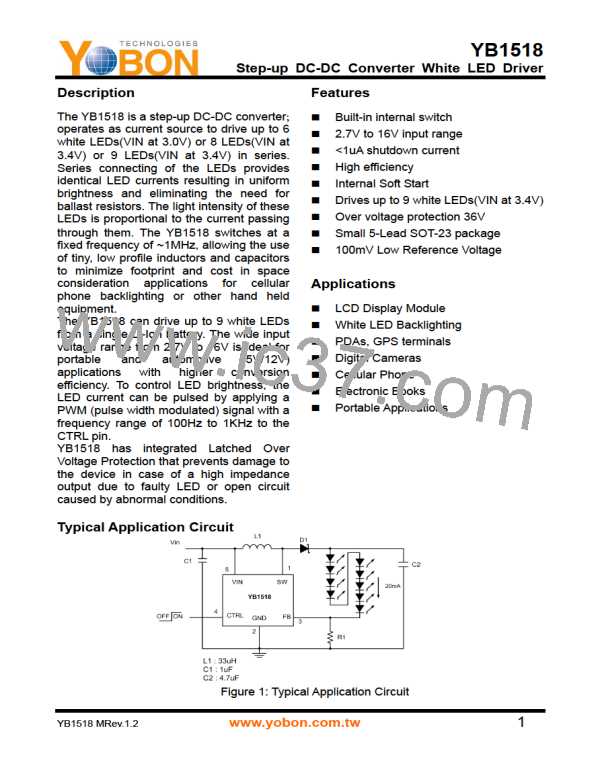YB1518
Step-up DC-DC Converter White LED Driver
Absolute Maximum Ratings
Recommended Operating Conditions
Operating Temperature ............................-40°C~85°C
VIN.........................................................................20V
SW Voltage............................................................36V Supply Voltage............................................ 2.7 V~16V
FB Voltage ...............................................................5V SW Voltage............................................................32V
CTRL Voltage...........................................................5V
Maximum Junction Temp,TJ .............................150°C
Lead Temperature (Slokering 10 sec) ................300°C
Thermal Resistance............................................195°C
Electricity Characteristics
(TA=25°C, Vin=3.3V, Cin=1uF Cout=10uF unless otherwise noted) Table 3
Symbol
Function Parameter
Input Voltage Range
Not Switching
Test Conditions
Min
2.7
Typ
Max
16
Units
V
Vin
VFB = 0.3V
CTRL = 0V
1.2
1.5
0.3
1.7
1
mA
uA
IQ (Quiescent
Current)
Shutdown
Iout=20mA,Vout=12.5V
Circuit of Figure 1
VFB
ICL
Feedback Voltage
90
100
110
mV
100% duty cycle
40% duty cycle
400
450
350
mA
mA
Switch Current Limit
IB
FB Pin Bias Current
Switching Frequency
VFB=100mV
1
uA
FRSW
900
20
930
960
KHz
DTMX
DTMN
VSAT
Maximum Duty Cycle
Minimum Duty Cycle
Switch Vcesat
85
25
%
%
At Isw = 200mA
Ctrl = 0.3V
180
mV
Switch Leakage
Current
ILKG
1
μA
VCTRL for Full LED
Current
Full On
Full Off
1.7
V
V
VCTL
ICTL
0.3
CTRL Pin Bias Current
Ctrl = 2V
40
μA
Over Voltage
Protection
OVP
34
V
θJA
Thermal Resistance
220
°C/W
Note:
Absolute maximum ratings are limits beyond which damage to the device may occur.
The maximum allowable power dissipation is a function of maximum function temperature , TJ(max), the
junction to ambient thermal resistance, θJA , and the ambient temperature. The maximum allowable, power
dissipation at any ambient temperature is calculated using: PD(MAX)= [TJ(max)-TA]/θJA . Exceeding the
maximum allowable power dissipation will cause excessive die temperature. All limits at temperature
extremes are guaranteed via correlation using standard statistical methods
YB1518 MRev.1.2
www.yobon.com.tw
3

 YOBON [ YOBON TECHNOLOGIES,INC. ]
YOBON [ YOBON TECHNOLOGIES,INC. ]